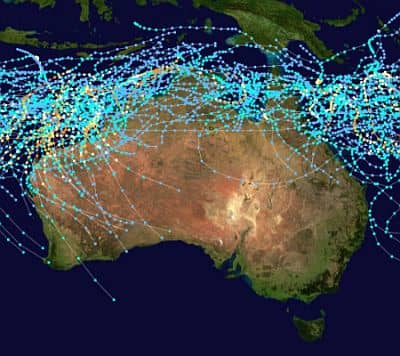Select units of measurement for the temperature and rainfall tables (metric or imperial).
December is the first summer month, and it is a hot, muggy and rainy month in the north, scorching in the desert areas, and very mild or pleasantly warm in the south-east.
In the
tropical north, in the Top End of the Northern Territory and in northern Queensland (see Darwin, Cairns), it is a hot, muggy and rainy month, with abundant rainfall.
On the
east coast (see Brisbane, Sydney), it is a hot month as well, with fairly frequent rain, but it is less rainy than in the north, and gradually less hot as you proceed south.
In the
Outback, the vast arid or desert inland area (see Alice Springs, Oodnadatta), there is scorching heat and the sun shines, although every now and then a thunderstorm can break out.
In the south, in the areas where the climate is Mediterranean (see Perth, Adelaide), it is a hot month, but without the excesses of the desert areas, and sunny.
In the
south-east, in the areas where the climate is oceanic (see Melbourne, Tasmania), the temperature is mild to pleasantly warm, and the weather is variable, sometimes cool and windy, with possible rains, although not very frequent.
As regards to the
temperatures, the daily average exceeds 30 °C (86 °F) in the hottest areas of the desert (see Tennant Creek), and also on the north-west coast (see Port Hedland), it is 23/24 °C (73/75 °F) on the east coast (see Brisbane, Sydney) and in Perth, while it drops to 18.5 °C (65 °F) in Melbourne, in the south-east, and to 16.5 °C (61 °F) in Hobart, in Tasmania.
Sometimes, on the central-southern coasts, there may be heat waves from the desert, during which the temperature can exceed 40 °C (40 °F).
Instead, in the south, air masses of Antarctic origin can bring a bit of
cold at night, with minimum temperatures below 10 °C (50 °F).
As regards to the
rain, summer in Australia is the wettest season in the center-north, even though the rainiest months are the coming ones, January and February. However, the rains are very abundant only in the tropical north (see Darwin, Cairns), and are relatively abundant, often in the form of showers or thunderstorms, on the east coast (see Brisbane, Sydney), while in the Outback, only rare thunderstorms occur.
In the south, in the areas where the climate is Mediterranean (see Perth, Adelaide), summer is the dry season. In the south-east, with an oceanic climate (see Melbourne, Tasmania), summer is the relatively dry season, however, the rains are quite frequent, though not abundant.
In the warm season, central-northern Australia, especially the coasts, can be affected by
tropical cyclones. Cyclones mainly affect the northern coasts, although they can sometimes penetrate inland (especially Western Australia), weakening along the way but still bringing heavy rainfall.
However, the period in which cyclones are most likely, which runs from January to mid-April, has not yet begun in December.
In the following image, we can see the areas that were affected by cyclones in the period 1950-2005 (the points refer to the eye of the storm, so the affected area is larger).
 Area affected by cyclones in Australia
Area affected by cyclones in Australia
In December, the
sea in Australia is warm enough for swimming in the center-north. In the tropical north it is very warm, on the east coast it is quite warm approximately up to Newcastle (north of Sydney), on the west coast it is a bit cool in Perth, while in the south, it is definitely cold in Melbourne and in Tasmania.
Australia is located at medium-low latitudes, however, in December the
days are quite long in the south, where the sun remains above the horizon for 14 hours or more. In the Southern Hemisphere, December is the month when the days are longest, and December 21st is the summer solstice.
Australia - Climate data in December| City | Rainfall | Sun | Daylight |
|---|
| (north to south) | Min | Max | Days | Hours | Hours |
|---|
| Darwin | 26 | 33 | 280 | 15 | 6.4 | 12.8 |
|---|
| Cairns | 24 | 32 | 185 | 11 | 7.5 | 13.1 |
|---|
| Port Hedland | 25 | 37 | 20 | 2 | 10.6 | 13.3 |
|---|
Alice Springs
(575 m.) | 21 | 36 | 40 | 5 | 10 | 13.6 |
|---|
| Brisbane | 19 | 28 | 130 | 9 | 8.5 | 13.8 |
|---|
| Oodnadatta | 22 | 37 | 20 | 3 | 11 | 13.8 |
|---|
| Perth | 16 | 30 | 10 | 2 | 11.5 | 14.2 |
|---|
| Sydney | 18 | 26 | 65 | 8 | 7.6 | 14.4 |
|---|
| Adelaide | 15 | 26 | 25 | 4 | 9.5 | 14.5 |
|---|
Canberra
(570 m.) | 12 | 27 | 55 | 5 | 9.4 | 14.5 |
|---|
| Melbourne | 12 | 24 | 60 | 6 | 8.5 | 14.7 |
|---|
| Hobart | 11 | 21 | 55 | 7 | 8 | 15.3 |
|---|
See also: Australia, the weather in
November -
JanuaryThe climate of
Australia